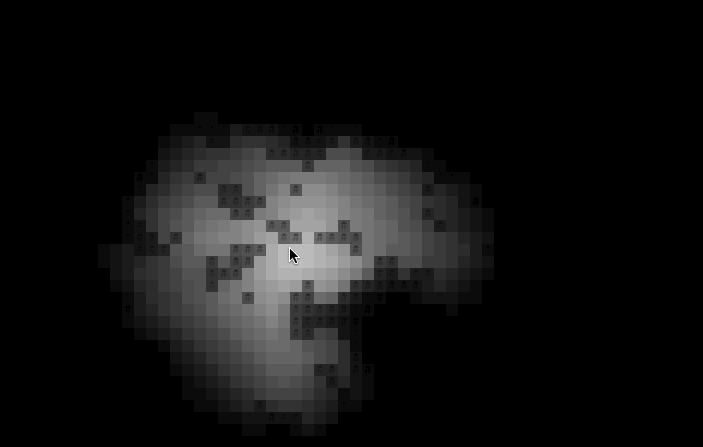A 2d flood-fill lighting engine
Full-color lighting can be achieved by using a separate LightMask for each color channel or by adjusting the computations to use 3 channels instead of 1.
The demo requires SDL2 to run. The LightMask engine itself has no external dependencies.
git clone https://github.com/nick-paul/LightMask.git
cd LightMask
mkdir build
cd build
cmake ..
make
./demo
// The lightmask itself
LightMask lightmask(WIDTH, HEIGHT);
// Intensity: Proportional to how far light spreads
lightmask.setIntensity(40.0f);
// Ambient: Ambient light (0.0f - 1.0f)
lightmask.setAmbient(0.4f);
// Vector representing wall opacities (1.0: solid, 0.0: clear)
// Stored in a single dimensional vector
// To set a wall value at (x,y) use walls[x + WIDTH * y] = ...
std::vector<float> walls(WIDTH * HEIGHT, 1.0f); // Reset the light mask
// Must be called every frame
lightmask.reset();
// All lights must be added between `reset()` and `computeMask()`
// Add a light with given brightness at location (x,y)
// brightness: 0.0 = no light, 1.0f = full light
lightmask.addLight(x, y, brightness);
// Compute the mask
// Pass the `walls` vector to the compute function
lightmask.computeMask(walls);Assume we are using the following to represent a Color object where each channel is a value from 0.0 to 1.0
struct Color {
float r;
float g;
float b;
}To compute the color of a tile at location (x,y) for rendering, multiply the color channels by the light mask at that location
// Assume the call `map.getTileColor(x,y)`
// gets the color of the map tile at location (x,y)
Color color = map.getTileColor(x,y);
// Multiply each of the channels by the light mask
// 0.0: dark, 1.0: bright
float tile_brightness = lightmask.mask[x + y * width];
Color lighting_color(
color.r * tile_brightness,
color.g * tile_brightness,
color.b * tile_brightness
);
// Render the tile with the new color
// Assume `render()` takes an object to render and a color to render it
// render(object, color)
render(map.getTile(x, y), lighting_color);- This was originally developed for a roguelike engine so framerate and performance were not a huge concern. If you have any performance improving ideas, submit an issue or a PR and I'd be happy to take a look.
- Currently, the blur function creates a black border of unlit tiles on the outer edges of the map. To avoid this, don't use the blur function or make the lightmask slightly larger than the renderer size.

